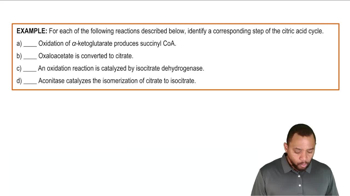Here are the essential concepts you must grasp in order to answer the question correctly.
Aerobic Oxidation
Aerobic oxidation is a metabolic process that requires oxygen to convert glucose into energy. This pathway involves glycolysis, the citric acid cycle, and oxidative phosphorylation, ultimately leading to the production of ATP. Oxygen acts as the final electron acceptor in the electron transport chain, facilitating the efficient extraction of energy from glucose.
Recommended video:
Aerobic Respiration Summary Concept 1
Acetyl-CoA
Acetyl-CoA is a crucial metabolic intermediate that plays a key role in energy production and biosynthesis. It is formed from the breakdown of carbohydrates, fats, and proteins and serves as a substrate for the citric acid cycle. The conversion of pyruvate to acetyl-CoA is a pivotal step linking glycolysis to aerobic respiration.
Recommended video:
Phase B - Succinyl CoA Formation Example 2
Role of Molecular Oxygen
Molecular oxygen is essential in aerobic respiration as it participates in the electron transport chain, where it accepts electrons and combines with protons to form water. This process not only drives ATP synthesis but also ensures the continuation of the electron transport chain by preventing the backup of electrons. Without oxygen, cells would rely on less efficient anaerobic pathways for energy production.
Recommended video:
 Verified step by step guidance
Verified step by step guidance


